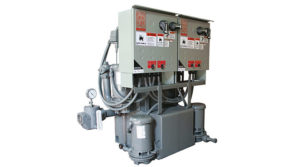We are often asked the question, “Can I replace a vacuum return condensate system with a standard condensate return unit?” Let’s look at what happens when a steam heating system starts up — a cycle that can happen many times a day, depending on the weather.
Steam Heating System
At startup on a two-pipe steam system, the steam mains, radiators, and dry return lines are drained, and the entire system above the boiler’s water line contains air. This means that any steam added to the heating zone must push that air out of the mains and radiators, via air vent valves or thermostatic traps on each radiator and at the end of the stream main. Heating begins as steam replaces the vented air.
Usually, the radiator nearest to where the steam enters the building heats first. Air is vented along the steam main, additional radiators receive steam. Depending on the steam main length and vent size, it may take 5 to 20 minutes for the system to vent and distribute heat throughout the building.
We tried using orifices to improve the balance of heating in large, single-zone heating systems. (Orifices reduce steam flowing to radiators at the steam main’s supply end.) In one-pipe systems, we installed adjustable air vent valves on steam radiators. While these methods helped, they could not adjust to different degree days, and the heating balance still suffered.
Vacuum System Advantages
Vacuum systems, however, overcome these difficulties by using a vacuum pump on the end of the return line to remove air from the system and maintain a 3” to 8” Hg vacuum. When the system is cold, the thermostatic traps are open, and air is removed the radiators and supply lines. Removing air increases the differential between the positive pressure in the boiler and the sub-atmospheric pressure in the rest of the system. Steam flow is several times faster than in standard atmospheric systems, improving heat balance and speeding startup.
Another advantage includes faster condensate return. Faster condensate return reduces surges caused by condensate buildup —which can cause frequent low-water cutoff at the boiler, and boiler flooding when large slugs of condensate suddenly return. Increased differential pressures across the system also let designers reduce return pipe sizes, reducing upfront costs. The system can also use lift fittings and drain low wetted return lines without an additional condensate return pump in a pit.
When today’s building operators consider replacing vacuum pumps with standard vented condensate units, the engineer/contractor should point out these vacuum system advantages. If the system is removed, occupants on one side of the building may start opening windows due to excessive heat, while other occupants complain about being cold. Noisy returns may become an issue because the smaller pipes of a vacuum system do not allow adequate condensate return on a vented system. Resulting holdup may lead to condensate surges that overwhelm the vented unit, dumping treated condensate down the drain instead of recovering it.
Increasing steam pressure or installing individual thermostatic radiator valves usually doesn’t work. The only way to eliminate the vacuum unit and maintain proper balance is to rezone the steam distribution lines. This requires additional thermostats, zone control valves, and even a complete re-piping — often impractical and seldom cost-effective.
Vacuum System Maintenance
That leaves you to maintain the vacuum system. Piping must be tight. Thermostatic traps must be maintained to control returning condensate temperature. The general guideline is 160ºF for peak efficiency, with a maximum of 180ºF, since the system is under a vacuum and flash temperature of the boiler water is reduced. Higher temperatures or flash steam can cause cavitation in the pumps, shorten seal life and damage other components, resulting in expensive repairs. Proper trap maintenance is key to system balance and vacuum pump life expectancy.
Typically, we see two types of vacuum units on vacuum heating systems. The combination vacuum condensate pump effectively uses the same pump for both functions, creating the vacuum and providing the pumping pressure to return condensate to the boiler or feed unit.
Other units use separate air removal and condensate pumps. This function allows for individual sizing of air removal capacity and water transfer capacity. (This is often needed in older systems to handle increased air leakage.) The separate air pump also lets you use a temperature limit switch in the return line or the condensate tank. This is needed to cut out the vacuum pumps when poor trap maintenance causes excessive condensate return temperatures. Some separate air removal and condensate pump systems can allow for this, as the vacuum is not critical when the system is up to operating temperature.
Other Uses
Vacuum boiler feed systems are also useful for boiler conversions. Newer boilers have considerably less water storage capacity. This means you need to install a boiler feed unit with a tank that can store condensate. With the vacuum pump installed on the feed unit, the condensate returns under vacuum directly to the feed tank. It is stored under vacuum until required by the boiler water level control.
Finally, note that eliminating your system’s vacuum return pumps will likely increase operating and fuel costs. A system designed for vacuum service includes pipes sized and located for vacuum service. In the end, it may simply be more practical to properly maintain the existing system and continue to operate under vacuum.
If you have any questions regarding this type of system, please don’t hesitate to contact us. A sales engineer will be happy to help you in determining the best way to address your needs.
This article was originally published by Steve Almgreen of the Bell & Gossett Steam Team.


